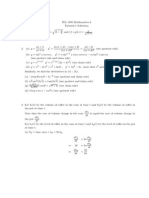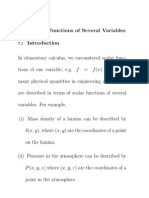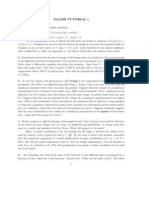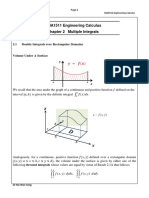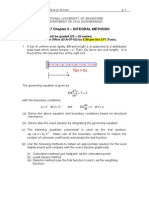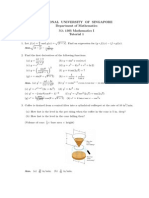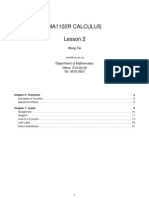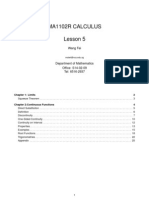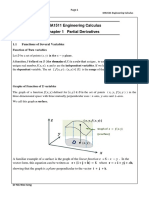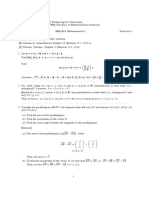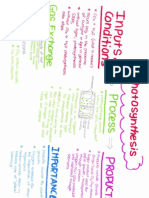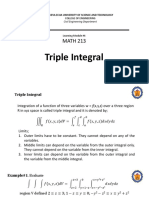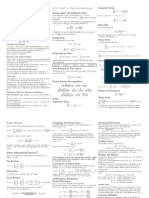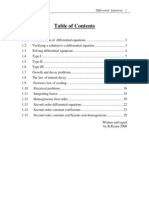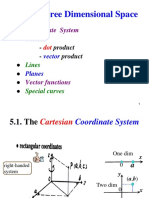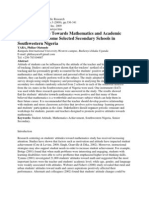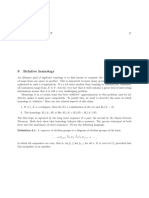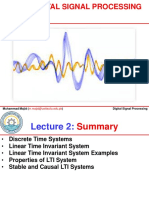0 ratings0% found this document useful (0 votes)
171 viewsNUS - MA1505 (2012) - Chapter 1
NUS - MA1505 (2012) - Chapter 1
Uploaded by
Gilbert SebastianoThis document introduces functions and limits. It defines a function as a rule that assigns a unique output value to each input value. Functions can be combined using arithmetic operations like addition and multiplication or composition. A limit describes the behavior of a function as the input values get closer to a particular value without reaching it. Specifically, the limit of a function f(x) as x approaches a is L if f(x) can be made arbitrarily close to L by making x sufficiently close to a, but not equal to a. The rules of limits, such as limiting sums and products, are then discussed.
Copyright:
© All Rights Reserved
Available Formats
Download as PDF, TXT or read online from Scribd
NUS - MA1505 (2012) - Chapter 1
NUS - MA1505 (2012) - Chapter 1
Uploaded by
Gilbert Sebastiano0 ratings0% found this document useful (0 votes)
171 views7 pagesThis document introduces functions and limits. It defines a function as a rule that assigns a unique output value to each input value. Functions can be combined using arithmetic operations like addition and multiplication or composition. A limit describes the behavior of a function as the input values get closer to a particular value without reaching it. Specifically, the limit of a function f(x) as x approaches a is L if f(x) can be made arbitrarily close to L by making x sufficiently close to a, but not equal to a. The rules of limits, such as limiting sums and products, are then discussed.
Original Description:
NUS Lecture Notes - MA1505 (2012) - Chapter 1
Copyright
© © All Rights Reserved
Available Formats
PDF, TXT or read online from Scribd
Share this document
Did you find this document useful?
Is this content inappropriate?
This document introduces functions and limits. It defines a function as a rule that assigns a unique output value to each input value. Functions can be combined using arithmetic operations like addition and multiplication or composition. A limit describes the behavior of a function as the input values get closer to a particular value without reaching it. Specifically, the limit of a function f(x) as x approaches a is L if f(x) can be made arbitrarily close to L by making x sufficiently close to a, but not equal to a. The rules of limits, such as limiting sums and products, are then discussed.
Copyright:
© All Rights Reserved
Available Formats
Download as PDF, TXT or read online from Scribd
Download as pdf or txt
0 ratings0% found this document useful (0 votes)
171 views7 pagesNUS - MA1505 (2012) - Chapter 1
NUS - MA1505 (2012) - Chapter 1
Uploaded by
Gilbert SebastianoThis document introduces functions and limits. It defines a function as a rule that assigns a unique output value to each input value. Functions can be combined using arithmetic operations like addition and multiplication or composition. A limit describes the behavior of a function as the input values get closer to a particular value without reaching it. Specifically, the limit of a function f(x) as x approaches a is L if f(x) can be made arbitrarily close to L by making x sufficiently close to a, but not equal to a. The rules of limits, such as limiting sums and products, are then discussed.
Copyright:
© All Rights Reserved
Available Formats
Download as PDF, TXT or read online from Scribd
Download as pdf or txt
You are on page 1of 7
Chapter 1.
Some Basics
1.1
Functions
It is common that the values of one variable depend
on the values of another. E.g. the area A of a region on the plane enclosed by a circle depends on
the radius r of the circle (A = r2, r > 0 .) Many
years ago, the Swiss mathematician Euler invented
the symbol y = f (x) to denote the statement that
y is a function of x.
A function represents a rule that assigns a unique
value y to each value x .
We refer to x as the independent variable and y the
dependent variable.
MA1505 Chapter 1. Functions: Limits and Continuity
One can also think of a function as an input-output
system/process: input the value x and output the
value y = f (x) . (This becomes particularly useful
when we combine or composite functions together.)
1.2
Operations on Functions
1.2.1
Arithmetical operations
Let f and g be two functions.
(i) The functions (f g)(x) = f (x) g(x), called
the sum or difference of f and g.
(ii) The function (f g)(x) = f (x)g(x), called the product of f and g.
(iii) The function (f /g)(x) = f (x)/g(x), called the
quotient of f by g, is defined where g(x) 6= 0;
2
1.2.2
MA1505 Chapter 1. Functions: Limits and Continuity
Composition
Let f : D R and g : D0 R be two (real)
functions with domains D and D0 respectively.
The function
(f g)(x) = f (g(x)),
called f composed with g or f circle g, is defined on
the subset of D0 for which the values g(x) (i.e. the
range of g) are in D.
1.2.3
Example
Let f (x) = x 7 and g(x) = x2 (defined on all of
R). Then
(f g)(2) = f (g(2)) = f (4) = 3, and
3
MA1505 Chapter 1. Functions: Limits and Continuity
(g f )(2) = g(f (2)) = g(5) = 25.
Note that in general f g 6= g f .
1.3
Limits
In this section we are interested in the behaviour of
f as x gets closer and closer to a.
1.3.1
Example
Let D = {x R : x 6= 0} and we consider the
sin(x)
. (x is
function f : D R given by f (x) =
x
in radian.) Describe its behaviour as x tends to 0.
sin(0) 0
Clearly when x = 0,
= does not make sense.
0
0
It is defined everywhere except at 0 and thus it makes
sense to ask how it behaves as it is evaluated at ar-
MA1505 Chapter 1. Functions: Limits and Continuity
guments which are closer and closer to 0.
If we plot the graph of
sin(x)
x ,
we see that as x gets
closer and closer to 0 from either sides (and not reaching 0 itself),
sin(x)
x
that the limit of
approaches 1. In this case, we say
sin(x)
x
as x tends to 0 is equal to 1.
We use the following notation:
sin(x)
= 1.
x0
x
lim
1.3.2
MA1505 Chapter 1. Functions: Limits and Continuity
Informal Definition
Let f (x) be defined on an open interval I containing
x0, except possibly at x0 itself. If f (x) gets arbitrary
close to L when x is sufficiently close to x0, then we
say that the limit of f (x) as x tends to x0 is the
number L and we write
lim f (x) = L.
xx0
1.3.3
Rules of Limits
Suppose lim f (x) = L and lim g(x) = L0, then the
xa
xa
following statements are easy to verify:
(i) lim (f g)(x) = L L0;
xa
(ii) lim (f g)(x) = LL0;
xa
MA1505 Chapter 1. Functions: Limits and Continuity
f
L
(iii) lim (x) = 0 provided L0 6= 0;
xa g
L
(iv) lim kf (x) = kL for any real number k.
xa
You might also like
- Global TalesDocument172 pagesGlobal Talespaula ladona100% (1)
- Holt Mathematics Course 2 Homework and Practice Workbook AnswersDocument8 pagesHolt Mathematics Course 2 Homework and Practice Workbook Answersafjwfzekzdzrtp100% (2)
- Discrete-Time Markov Chains: He ShuangchiDocument61 pagesDiscrete-Time Markov Chains: He ShuangchiZhengYang ChinNo ratings yet
- MA1505 Tutorial Solution 1Document6 pagesMA1505 Tutorial Solution 1Bilguun BatboldNo ratings yet
- PM5114 IVLE Lecture1Document23 pagesPM5114 IVLE Lecture1Ravi ShankarNo ratings yet
- CE6102 - 5 - Application of Newton Raphson Techniques To Elasto-Plastic Model With Constant Yield SurfacesDocument9 pagesCE6102 - 5 - Application of Newton Raphson Techniques To Elasto-Plastic Model With Constant Yield SurfacesandreashendiNo ratings yet
- NUS - MA1505 (2012) - Chapter 7Document42 pagesNUS - MA1505 (2012) - Chapter 7Gilbert SebastianoNo ratings yet
- MA1506Document70 pagesMA1506ernie123219405No ratings yet
- NUS - MA1505 (2012) - Chapter 6Document27 pagesNUS - MA1505 (2012) - Chapter 6Gilbert SebastianoNo ratings yet
- 1718sem2 Ma1511Document3 pages1718sem2 Ma1511杨过No ratings yet
- MA1511 Engineering Calculus Chapter 5 Infinite Series: 5.1 SequencesDocument20 pagesMA1511 Engineering Calculus Chapter 5 Infinite Series: 5.1 SequencesKang Le LimNo ratings yet
- MA1301 Chapter 2Document104 pagesMA1301 Chapter 2Pulipati Shailesh AvinashNo ratings yet
- MA1511 Chapter 2Document14 pagesMA1511 Chapter 2Kang Le LimNo ratings yet
- MA1301 Tutorial 4 SolutionDocument20 pagesMA1301 Tutorial 4 SolutionPulipati Shailesh AvinashNo ratings yet
- CH 5 Tutorial 2014Document4 pagesCH 5 Tutorial 2014Luke LdhNo ratings yet
- MH1811 Tutorial 6 SS 2020 SeqDocument2 pagesMH1811 Tutorial 6 SS 2020 SeqYachen WuNo ratings yet
- MA1511 Chapter 4Document18 pagesMA1511 Chapter 4Kang Le LimNo ratings yet
- MA1505 Tutorial 1 QuestionsDocument4 pagesMA1505 Tutorial 1 QuestionsBilguun BatboldNo ratings yet
- MA1511 Chapter 3Document20 pagesMA1511 Chapter 3Kang Le LimNo ratings yet
- Ma1102R Calculus Lesson 2: Wang FeiDocument12 pagesMa1102R Calculus Lesson 2: Wang FeidelsonwiestNo ratings yet
- Ma1102R Calculus Lesson 5: Wang FeiDocument14 pagesMa1102R Calculus Lesson 5: Wang FeidelsonwiestNo ratings yet
- 1112sem2 Ma1505Document6 pages1112sem2 Ma1505Dillon ChewNo ratings yet
- Slides MH1810 2016 Part 1 1 Complex TWK Mon 8 8Document89 pagesSlides MH1810 2016 Part 1 1 Complex TWK Mon 8 8Hui Min TehNo ratings yet
- Ma1102R Calculus Lesson 17: Wang FeiDocument5 pagesMa1102R Calculus Lesson 17: Wang FeidelsonwiestNo ratings yet
- Ma1102R Calculus Lesson 8: Wang FeiDocument13 pagesMa1102R Calculus Lesson 8: Wang FeidelsonwiestNo ratings yet
- Ma1102R Calculus Lesson 8: Wang FeiDocument14 pagesMa1102R Calculus Lesson 8: Wang FeidelsonwiestNo ratings yet
- 5 - Ce6101-Cam Clay Model-03102020Document30 pages5 - Ce6101-Cam Clay Model-03102020rihongkeeNo ratings yet
- MA1511 1819S1 Chapter 1 Partial DerivativesDocument24 pagesMA1511 1819S1 Chapter 1 Partial DerivativesHanguk Germerio ShinNo ratings yet
- MH1810 Tut 2 2016 Vectors SolnDocument9 pagesMH1810 Tut 2 2016 Vectors SolnTeckWeeTwTwNo ratings yet
- CV6314 Lecture 1Document22 pagesCV6314 Lecture 1Thet LinnNo ratings yet
- MH1810 Notes 2023 (Part1)Document82 pagesMH1810 Notes 2023 (Part1)Felix Ivander SalimNo ratings yet
- Lecture Probabilistic Approach in Slope Stability AnalysesDocument26 pagesLecture Probabilistic Approach in Slope Stability AnalysesZanele MbathaNo ratings yet
- Ma1102R Calculus Lesson 21: Wang FeiDocument9 pagesMa1102R Calculus Lesson 21: Wang FeidelsonwiestNo ratings yet
- IE 5004 Lecture 2Document45 pagesIE 5004 Lecture 2Prashant TolaniNo ratings yet
- Photosynthesis Concept MapDocument1 pagePhotosynthesis Concept MapkrtcMP100% (1)
- MA1505 12S2 Mid-Term Test InformationDocument6 pagesMA1505 12S2 Mid-Term Test InformationamehbeeNo ratings yet
- CV3013 Lect10 EarthPressures Sept2019Document25 pagesCV3013 Lect10 EarthPressures Sept2019AnmolNo ratings yet
- MSC Ge Modules DescriptionDocument4 pagesMSC Ge Modules Descriptionkhin600No ratings yet
- IMSO2021. Training - 3Document2 pagesIMSO2021. Training - 3Linh Phan PhươngNo ratings yet
- MATH 213: Triple IntegralDocument13 pagesMATH 213: Triple IntegralAnjanette ManubayNo ratings yet
- Probabilistic Assessment of Stability of A Cut SloDocument9 pagesProbabilistic Assessment of Stability of A Cut SlolfbNo ratings yet
- MA1301 Help SheetDocument3 pagesMA1301 Help SheetChng Pei SzeNo ratings yet
- Ma1505 CheatDocument4 pagesMa1505 CheatSouseiseki ChromeNo ratings yet
- MH1810 Tut 1 2013 ComplexDocument3 pagesMH1810 Tut 1 2013 ComplexNhân TrầnNo ratings yet
- 11 Cylindrical and Spherical Coordinates - HandoutDocument23 pages11 Cylindrical and Spherical Coordinates - HandoutJohnNo ratings yet
- Eigenvalues EigenfunctionsDocument23 pagesEigenvalues Eigenfunctionsjhalaniparth2005No ratings yet
- 2 - Ce6101 An Introduction To Plasticity-20092020Document88 pages2 - Ce6101 An Introduction To Plasticity-20092020rihongkeeNo ratings yet
- Notes Differential EquationsDocument37 pagesNotes Differential EquationsYongHwan SeoNo ratings yet
- Chapter 11Document23 pagesChapter 11morry123No ratings yet
- Chap 3 Weighted Residual and Energy Method For 1D Problems: Finite Element Analysis and Design Nam-Ho KimDocument47 pagesChap 3 Weighted Residual and Energy Method For 1D Problems: Finite Element Analysis and Design Nam-Ho KimNarendra KulkarniNo ratings yet
- P6 PAL Science L13 Forms and Uses of Energy-1Document24 pagesP6 PAL Science L13 Forms and Uses of Energy-1XuaN XuanNo ratings yet
- MATH2023 Multivariable Calculus Chapter 3 Partial Derivatives L2/L3 (Fall 2019)Document36 pagesMATH2023 Multivariable Calculus Chapter 3 Partial Derivatives L2/L3 (Fall 2019)物理系小薯No ratings yet
- 7 - CE6101 More On Cam Clay & MCC - PPT HandoutsDocument12 pages7 - CE6101 More On Cam Clay & MCC - PPT HandoutsrihongkeeNo ratings yet
- CH 6 Tutorial 2016Document5 pagesCH 6 Tutorial 2016Steven KuaNo ratings yet
- Kumbojkar Triple IntegralsDocument23 pagesKumbojkar Triple Integralsaditya.sschNo ratings yet
- CE5105 Assignment CA1 A193977B PDFDocument28 pagesCE5105 Assignment CA1 A193977B PDFMayoo LaxmanNo ratings yet
- Transformation of Functions MsDocument4 pagesTransformation of Functions MssalmasomaNo ratings yet
- Three Dimensional Space: Coordinate SystemDocument82 pagesThree Dimensional Space: Coordinate Systemlzyabc597No ratings yet
- TEMA 0. Review On CalculusDocument12 pagesTEMA 0. Review On CalculusMaría VelaNo ratings yet
- Math 150 Exam 1 Review SheetDocument3 pagesMath 150 Exam 1 Review SheetTuongVNguyenNo ratings yet
- MEV1.2 (Part 8) SolutionsDocument7 pagesMEV1.2 (Part 8) SolutionsPrathmesh SinhaNo ratings yet
- CH 4Document17 pagesCH 4Smith100% (1)
- Physics 430: Lecture 15 Lagrange's Equations: Dale E. GaryDocument16 pagesPhysics 430: Lecture 15 Lagrange's Equations: Dale E. GaryJohn SmithNo ratings yet
- Material Science Professor S. K. Gupta Department of Applied Mechanics Indian Institute of Technology Delhi Lecture No 4 Crystal GeometryDocument23 pagesMaterial Science Professor S. K. Gupta Department of Applied Mechanics Indian Institute of Technology Delhi Lecture No 4 Crystal GeometryPrateek PandeyNo ratings yet
- Students Attitude Towards Mathematics and Academic Achievement in Some Selected Secondary Schools in Southwestern NigeriaDocument7 pagesStudents Attitude Towards Mathematics and Academic Achievement in Some Selected Secondary Schools in Southwestern NigeriaJason ValenciaNo ratings yet
- PR Proposal Final PDFDocument5 pagesPR Proposal Final PDFOdyssey CabahugNo ratings yet
- Maths-Formula-Book-1st-Edition-2024-Pinnacle-English-Medium_cutter (2)Document1 pageMaths-Formula-Book-1st-Edition-2024-Pinnacle-English-Medium_cutter (2)sacixoy334No ratings yet
- MIT18 905F16 Lec8Document5 pagesMIT18 905F16 Lec8Arindam BandyopadhyayNo ratings yet
- Digital FiltersDocument50 pagesDigital FiltersJoseNo ratings yet
- Math100Part2 ProbabilitySimpleEventsDocument6 pagesMath100Part2 ProbabilitySimpleEvents전실 안No ratings yet
- (Laurent Lessard) LP DualityDocument28 pages(Laurent Lessard) LP DualityLeonardo Gama AssumpçãoNo ratings yet
- BMATE101 Set 1Document3 pagesBMATE101 Set 1swatikammar60No ratings yet
- 2018amc J EngDocument7 pages2018amc J EngHero ZhaoNo ratings yet
- Exercises: 2 / Basic Structures: Sets, Functions, Sequences, Sums, and MatricesDocument2 pagesExercises: 2 / Basic Structures: Sets, Functions, Sequences, Sums, and MatricesAKum អាគមNo ratings yet
- ES 61 Introduction and Lesson 1Document40 pagesES 61 Introduction and Lesson 1Fabie BarcenalNo ratings yet
- m101 Homework AnswersDocument5 pagesm101 Homework Answerserajkd5h100% (1)
- Chapter 1Document26 pagesChapter 1yassinassem910203No ratings yet
- Limited Dependent Variable ModelsDocument9 pagesLimited Dependent Variable ModelsApga13No ratings yet
- Grade-7 Term1 WorksheetsDocument49 pagesGrade-7 Term1 WorksheetsHijab ZahraNo ratings yet
- Moroccan Mosaic PowerpointDocument14 pagesMoroccan Mosaic Powerpointapi-242485611No ratings yet
- First Year Calculus: WwlchenDocument5 pagesFirst Year Calculus: WwlchennigerianhacksNo ratings yet
- QM PDFDocument193 pagesQM PDFJohn RoasaNo ratings yet
- DSP Lecture 3 PDFDocument35 pagesDSP Lecture 3 PDFMuhammad SubhanNo ratings yet
- 18mab204t - MCQ (I-V)Document15 pages18mab204t - MCQ (I-V)vasu buchingariNo ratings yet
- Introduction To Competitive ProgrammingDocument31 pagesIntroduction To Competitive ProgrammingPikachuNo ratings yet
- Cartesian Plane PDFDocument2 pagesCartesian Plane PDFapi-362546999No ratings yet
- Multiplication & Division of RadicalsDocument7 pagesMultiplication & Division of RadicalsVenus NamocNo ratings yet
- Tutorial 1 Getting Started With MATLABDocument142 pagesTutorial 1 Getting Started With MATLABSoavan SahuNo ratings yet
- Last Pa Check Na Jud Sa Research 1Document24 pagesLast Pa Check Na Jud Sa Research 1Ruffa M. MeñozaNo ratings yet



